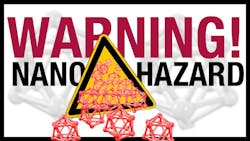Taming Nanotechnology's Potential Risks
All signs point toward the industrial and economic impact of nanotechnology getting exponentially bigger in the very near future -- to the tune of $3 trillion by 2015, according to some projections.
This microscopic technology, which utilizes particles and engineered structures as small as one ten-thousandth the diameter of a human hair, has already found practical application in medical technology, pharmaceuticals, and personal care products. It is poised to transform electronics and communications, manufacturing processes and tools, materials development, pollution control, batteries, and other products and industries.
But the health and environmental effects of most nanotechnologies are not well studied or understood, and a growing body of evidence suggests that some types of nanotechnology might be associated with significant adverse effects on human health and the environment.
Some in the insurance industry have already labeled nanotechnology as an emerging risk, and, to compound the uncertainty, complex concerns regarding regulatory oversight are on the rise, not to mention calls to ban nanotechnology outright.
So where does this leave manufacturers, innovators and other businesses whose industries are ready to ride the wave of nanoparticles into the future? Likely facing a host of potential lawsuits at some point for a number of potential reasons.
While no nanotechnology-specific personal injury claims have been brought against manufacturers yet, and no specific human disease or verifiable environmental mishap has been ascribed to nanomaterials, such claims are practically inevitable.
But understanding the potential risks and courtroom implications can help manufacturers and other businesses in the supply chain take proactive steps to manage and minimize their exposure to liability.
Potential Nanotechnology Claims
A May 2008 New York Times article stated that nanotubes, one of the wonder materials of the new age of nanotechnology, may carry a health risk similar to that of asbestos. Even before that, some commentators called nanotechnology the “asbestos of the future,” and the journal Nature Nanotechnology reported that nanotubes injected into the abdomens of mice induced lesions similar to those that appear on the outer lining of the lungs after the inhalation of asbestos.
While the research in this area is far from complete, manufacturers should note that the total number of asbestos cases brought by plaintiffs has already soared past half a million, and total corporate liability for asbestos-related injuries is estimated to reach over $200 billion.
If the history of asbestos is any indicator, injury and tort claims following the industrial and consumer uses of nanotechnology will come from workers exposed to nanoparticles during production as well as from professionals and consumers who are the end users of those products.
When nano-tort claims are ultimately made, they will likely cover the full range of tort litigation and include claims by individual plaintiffs, class action litigation, workers’ compensation claims, environmental contamination and cleanup claims, consumer protection claims, and property damage claims.
Manufacturers and distributors can expect to face litigation that is based primarily on traditional product liability principles, alleging that injuries are the result of design defects, manufacturing defects, and defects as a result of inadequate warnings or instructions.
It may take at least another decade for major mass or toxic tort nanotechnology claims to arise. As a writer in the American Bar Association’s Mass Torts has noted, the sophisticated toxic tort and mass tort bar understands that the science required to assess the potential hazards of nanomaterials in the fields of toxicology, epidemiology, and industrial hygiene, as well the need to be able to satisfy the Daubert standard for admissibility of scientific evidence, is years away. Therefore, medical monitoring claims -- which seek damages not for actual injury, but for the increased risk of future harm due to exposure to a substance -- may be the most likely early nano-tort claims.
Avoiding Nano-Tort Litigation
Prior to a nano-tort claim being made, corporations should undertake measures to limit the harm and liability exposure. These measures span all aspects of business and include research, development, and testing; compliance with regulations and industry guidelines; manufacturing and quality control; advertising, marketing, and promotion of a product; addressing express and implied warranties; packaging, distribution, and transport; maintenance and repair; product disposal; control and retention of documents; and crisis management.
While all of these areas cannot be described in detail here, below are a few basic principles to help get started.
One of the best defenses to avoid nano-tort litigation is to post adequate safety warnings for workers and consumers, so the manufacturer may employ what is known as the “sophisticated user” defense. This defense asserts that even though there may have been a defect in a product that caused damage or injury, the defendant had no duty to warn of the dangerous condition because users were educated about potential danger. Companies should also do enough safety tests of their products to show they were reasonably diligent.
Potential nano-tort defendants will also need to stay abreast of the developing research and monitor regulations and industry codes that are being considered or promulgated. A comprehensive regulatory scheme to govern nanotechnology is far from in place -- even an issue as seemingly straightforward as defining “nanomaterials,” which is a necessary step for effective regulation, is fraught with technical and other problems. But it is on the horizon, and there have already been two administrative lawsuits concerning the regulation of the environmental and health risks associated with nanomaterials.
The Environmental Protection Agency has taken preliminary but meaningful steps involving consent orders with a carbon nanotube manufacturer and proposed rules under the Toxic Substances Control Act. Some states and municipalities, such as California’s Department of Toxic Substances Control and the cities of Berkeley, California and Cambridge, Massachusetts, have tiptoed into the regulatory fray. Others may begin seeking oversight of the nanotechnology businesses within their boundaries. In 2011, the Food and Drug Administration published an initial draft guidance report regarding products containing nanomaterials.
Aside from these areas, manufacturers may see any number of environmental laws applied to nanotechnology lawsuits or revised to specifically incorporate nanotechnology.
The Toxic Substances Control Act may have the greatest impact and application to nanotechnology because it is a front-loaded statute directing the EPA to regulate chemicals before they come to market and also while they are in use. Others may include the Federal Insecticide, Fungicide, and Rodenticide Act; the Clean Air and Clean Water Acts; the Resource Conservation and Recovery Act; the Comprehensive Environmental Response, Compensation, and Liability Act; and the National Environmental Policy Act.
A proactive approach involves working with experienced counsel to monitor regulatory development and the applicability of these and other laws to particular operations or product lines.
Finally, prudent manufacturers should consider insurance policies specifically covering claims arising from nanotechnology. There are now brokers specializing in procuring nanotechnology companies with appropriate insurance to cover them in case they become a defendant in a nano-tort claim.
Our research has not found any nano-tort litigation against manufacturers to date, and no specific human disease or verifiable environmental mishap has been ascribed to nanomaterials. Still, there has already been at least one recall of a nanotechnology-based product because of reports of personal injury, and respiratory cases involving nanomaterials have been reported in Germany and China. For an advancement defined by its astonishing lack of size, nanotechnology’s impact on industry promises to get exponentially bigger -- and with that growth will likely come even greater liability implications.
Troy S. Flascher is an associate at Goldberg Segalla. His general litigation practice includes claims involving products liability, transportation, premises liability, medical malpractice, and contractual liability.


